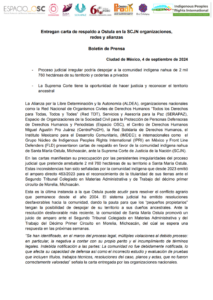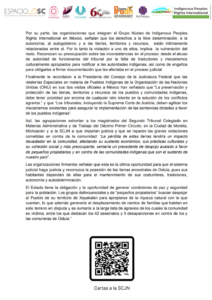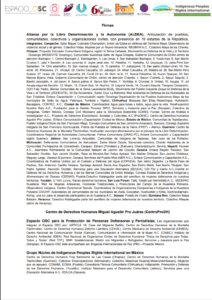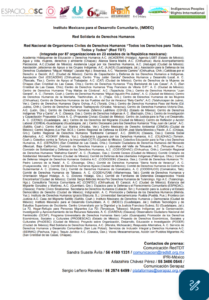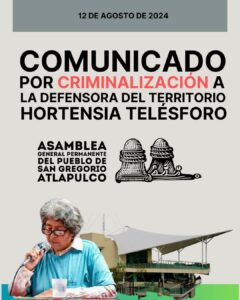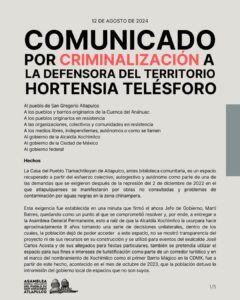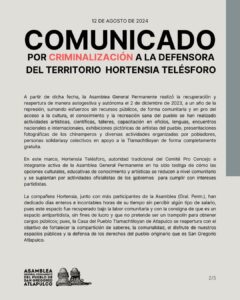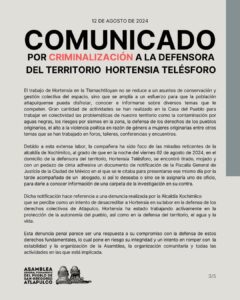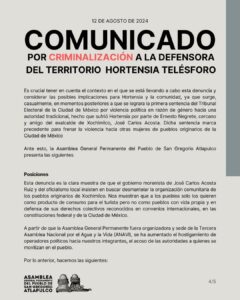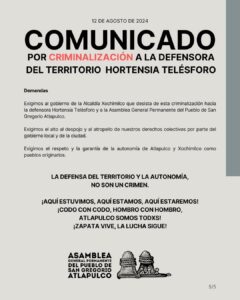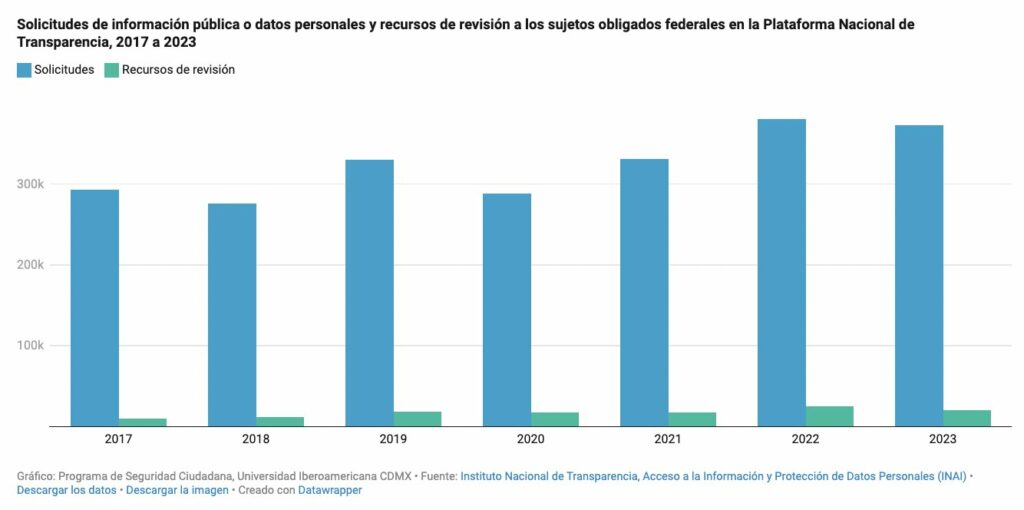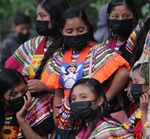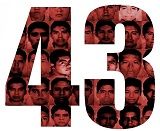Entregan carta de respaldo a Ostula en la SCJN organizaciones, redes y alianzas
Ciudad de México, 4 de septiembre de 2024
-Proceso judicial irregular podría despojar a la comunidad indígena nahua de 2 mil 760 hectáreas de su territorio y cederlas a privados
– La Suprema Corte tiene la oportunidad de hacer justicia y reconocer el territorio ancestral
La Alianza por la Libre Determinación y la Autonomía (ALDEA), organizaciones nacionales como la Red Nacional de Organismos Civiles de Derechos Humanos “Todos los Derechos para Todas, Todos y Todes” (Red TDT), Servicios y Asesoría para la Paz (SERAPAZ), Espacio de Organizaciones de la Sociedad Civil para la Protección de Personas Defensoras de Derechos Humanos y Periodistas (Espacio OSC), el Centro de Derechos Humanos Miguel Agustín Pro Juárez (CentroProDH), la Red Solidaria de Derechos Humanos, el Instituto Mexicano para el Desarrollo Comunitario, (IMDEC); e internacionales como el Grupo Núcleo de Indigenous Peoples Rights International (IPRI) en México y Front Line Defenders (FLD) presentaron cartas de respaldo en favor de la comunidad indígena nahua de Santa María Ostula, Michoacán, ante la Suprema Corte de Justicia de la Nación (SCJN).
En las cartas manifiestan su preocupación por las persistentes irregularidades del proceso judicial que pretende arrebatarle 2 mil 760 hectáreas de su territorio a Santa María Ostula. Estas inconsistencias han sido señaladas por la comunidad indígena que desde 2023 emitió el amparo directo 463/2023 para el reconocimiento de la titularidad de sus tierras ante el Segundo Tribunal Colegiado en Materias Administrativa y de Trabajo del décimo primer circuito de Morelia, Michoacán.
Esta es la última instancia a la que Ostula puede acudir para resolver el conflicto agrario que permanece desde el año 2004. El sistema judicial ha emitido resoluciones desfavorables hacia la comunidad, dando la pauta para que los “pequeños propietarios” tengan la posibilidad de despojar de su territorio a sus dueños ancestrales. Ante la resolución desfavorable más reciente, la comunidad de Santa María Ostula promovió un juicio de amparo ante el Segundo Tribunal Colegiado en Materias Administrativa y del Trabajo del Décimo Primer Circuito en Morelia, Michoacán, del cuál se espera una respuesta en las próximas semanas.
“Se han identificado, en el marco del proceso legal, múltiples violaciones al debido proceso: en particular, la negativa a contar con su propio perito y el incumplimiento de términos legales. Indebida notificación a las partes: La comunidad no fue debidamente notificada, lo que afecta su capacidad de defensa así como el incorrecto estudio y evaluación de pruebas que incluyen títulos, trabajos técnicos, resoluciones del caso, planos y actas, que no fueron correctamente valoradas” señala la carta entregada por las organizaciones nacionales.
Por su parte, las organizaciones que integran el Grupo Núcleo de Indigenous Peoples Rights International en México, señalan que los derechos a la libre determinación, a la autonomía, al autogobierno y a las tierras, territorios y recursos, están íntimamente relacionados entre sí. Por lo tanto la violación a uno de ellos, implica la vulneración del resto. Reconocen su preocupación sobre las inconsistencias en el proceso: desde el abuso de autoridad de funcionarios del tribunal por la falta de traductores y mecanismos culturalmente apropiados para notificar a las autoridades indígenas, así como de engaños para obligarles a firmar documentación que les afectaba en el proceso judicial.
Finalmente le recordaron a la Presidenta del Consejo de la Judicatura Federal que las relatorías Especiales en materia de Pueblos Indígenas de la Organización de las Naciones Unidas (ONU) en sus dos visitas oficiales a México han señalado que “La preservación y protección de las tierras, territorios y recursos de los pueblos y comunidades indígenas, debe tener prioridad por encima de cualquier otro interés en la solución de los conflictos agrarios.” y que “Los tribunales, incluyendo la Suprema Corte de Justicia, deben agilizar los mecanismos existentes para asegurar la implementación de las sentencias dictadas a favor de los pueblos indígenas”.
Así, las agrupaciones exhortan a los magistrados del Segundo Tribunal Colegiado en Materias Administrativa y de Trabajo del Décimo Primer Circuito, en la Ciudad de Morelia, Michoacán y a la SCJN a que impartan justicia y que se reparen las graves violaciones cometidas en contra de la comunidad: “La pérdida de estas tierras tendría un impacto devastador en la comunidad, afectando su sustento económico, sus prácticas culturales y su cohesión social y más preocupante, sentaría un precedente de despojo avalado a favor de pequeños propietarios y en contra de las comunidades indígenas que son el sustento de nuestro país”.
Las organizaciones firmantes señalan que esta es la última oportunidad para que el sistema judicial haga justicia y reconozca la posesión de las tierras ancestrales de Ostula, pues sus habitantes dependen de ellas para el mantenimiento de sus costumbres, tradiciones, autonomía y autodeterminación.
El Estado tiene la obligación y la oportunidad de generar condiciones de paz y seguridad para la población. Los grupos delincuenciales y de “pequeños propietarios” buscan despojar al Pueblo de su territorio de Xayakalan para apropiarse de la riqueza natural con la que cuentan, lo que además generaría el desplazamiento de cientos de familias que habitan en este terreno en disputa y se sumaría a la larga lista de agravios de los cuales la comunidad es víctima, entre los que destacan los 42 asesinatos y 5 desapariciones en contra de los y las comuneras de Ostula.”
Firmas
Alianza por la Libre Determinación y la Autonomía (ALDEA). Articulación de pueblos, comunidades, colectivos y organizaciones civiles, con presencia en 19 estados de la República. Integrantes: Campeche: Ejido Miguel Colorado Champotón, Unión de Ejidos en defensa del Territorio Maya, Observatorio de violencia social y de género, Colectivo Vidas, Mujeres por un Nuevo Amanecer, REDMYH A.C., Colectivo Maya de los Chenes; Chiapas: Proyecto Educador Comunitario Indígena, región VI Selva Cañadas, Movimiento en Defensa de la Vida y el Territorio-Ocosingo (MODEVITE Ocosingo), Comunidad Suclumpa Salto de Agua Chiapas, Gobierno Comunitario de Chilón centro de atención Bachajon: 1. Centro Bachajón,2. Xlemlajanten, 3. Las Limas, 4. San Sebastian Bachajon, 5. Yulub-max, 6. San Martín Cruzton,7. Jalal 1 Sección, 8. Las conchita, 9. Joybe yetal wits, 10. Pataliha, 11. Yaxtelha, 12. Uxyoquet, 13. Julba Pimil San Sebastian, 14. Chic abantelho, 15. San marcos uhaayil, 16. Ti cantelha, 17. Julbacpimil, 18. San pablo Chalam chén, 19. Yax winie, 20. Primavera, 21. Uhcayil, 22. Centro Cacualha, 23. Jetoaquil, 24. Ahlan Cacualha, 25. Waleha sil, 26. San Martin Pino Suárez, 27. Israel, 28. Carmen Cacualha, 29. Coral Ch´en, 30. Nich´ te´el, 31. Nueva Palestina, 32. Nuevo Tepeyac, 33. San Marcos Buena Vista, Gobierno Comunitario de Chilón, centro de atención C’ubwitz: 1. Sacun C’ubwitz, 2. Sacun Saquila, 3.Bawitz Jerusalén, 4. Jol sacun, 5. Sacun palma, 6. Sacun San Pedro, 7. Yochibja, 8. Q’uicisal, 9. Onteel, 10. Axupja, 11. Jol Axupja segunda Sección, 12. Mojón, 13. C’anal Ulub, 14. Nup’ha, 15. Laguna Verde, 16. Crucero Saquila, Tianguis Campesino, CDH Fray Pedro, Bienes Comunales de la Selva Lacandona BCZL, Movimiento del Pueblo Creyente Zoque en Defensa de la Vida y el Territorio (ZODEVITE), 20 De Noviembre, Santa Cruz La Reforma, Red Ambiental en Defensa de los Humedales de San Cristóbal, Enlace Capacitación y Comunicación región Ocosingo,Organización de los Pueblos Autónomos Maya de los municipios de Salto de Agua, Palenque, Tumbala y Yajalon; Chihuahua: Bosques San Elías Repechique, Huitosachi, Bacajípare, CONTEC, A.C.; Ciudad de México: Coordinadora Agua para todas y todos, agua para la vida, Tonelhuayotzin Nuestra Raíz A.C., Fundación para el Debido Proceso DPLF, Servicios y Asesoría para la Paz (Serapaz), Colectivo de Abogadas, Oxfam México, Consejo Civil Mexicano para la Silvicultura Sostenible CCMSS, Fundar, Centro de Análisis e Investigación A.C., Proyecto de Derechos Económicos, Sociales y Culturales, A.C (ProDESC), Centro de Derechos Humanos Agustín Pro Juárez, Enlace Comunicación y Capacitación Ciudad de México; Estado de México: Comunidad de Tepetlaoxtoc, Pueblo Indígena Otomí de San Francisco Magú, Concejo Comunitario de San Jerónimo Amanalco, Texcoco, Consejo Supremo Indígena de San Francisco Xochicuautla, Frente de Pueblos en Defensa de la Tierra (FPDT) – Atenco; Guerrero: Centro de Derechos Humanos de la Montaña Tlachinollan, Huehuetán municipio afromexicano por el principio de la Libre Determinación, Coordinadora Regional de Autoridades Comunitarias- Policía Comunitaria (CRAC-PC), Enlace Comunicación y Capacitación región Guerrero; Jalisco: San Lorenzo Azqueltán, Comunidad de Indígena de Tepizoac, San Juan de los Potreros; Michoacán: Defensores Comunitarios de Nahuatzen, Santa María Ostula, Xamoneta colectiva, Cherán Habitantes de la Comunidad Purhépecha de Comachuén, Carapan, Ésheni (Pichátaro y Zirahuen), Cheranatzicurín, Sevina; Nayarit: NuIwari A.C., Asamblea Permanente de la Comunidad Náayeri de Jazmín del Coquito; Oaxaca: Enlace Región Tlaxiaco, San Sebastián Ocotlán, San Jacinto Ocotlán, Tejas de Morelos,San Felipe Apóstol, San Matías Chilazao, San Jacinto Chilateca, Maguey Largo, Oaxaca El porvenir, Oaxaca, Servicios del Pueblo Mixe (SER A.C.), Enlace Comunicación y Capacitación A.C., Coordinadora de Pueblos Unidos por el Cuidado y Defensa del Agua (COPUDA), San Isidro Zegache, La Barda Paso de Piedras, San Antonino Castillo Velasco, Santiago Apóstol, Santa Ana Zagache, San Pedro Mártir, San Martín Tilcajete, San Pedro Apóstol, Asunción Ocotlán, Servicios para una Educación Alternativa (EDUCA), CDI Flor y Canto A.C.,Comité en Defensa de los Derechos Humanos y de los Bienes Comunales de Unión Hidalgo, Consejo Estatal de Derechos Indígenas y Afromexicano de Oaxaca (CEDIAO); Puebla: Colectivo Kalakgpaliw parte del semillero de mujeres defensoras de nuestros territorios; Yucatán: U Yich Lu’um, Kanan derechos humanos; San Luis Potosí: Tlalij, Yolojtli uan Nemililistlij A. C., SEDEPAC Huasteca, Red de Mujeres Artesanas, Cocineras Tradicionales y Productoras del Campo de la Huasteca Potosina, Observatorio Indígena, Centro Ceremonial Teenek, Coordinadora de Organizaciones Campesinas e Indígenas de la Huasteca Potosina COCIHP, Autoridades de comunidades de los municipios de Axtla, Coxcatlan, Huehuetlán y Xilitla, Xochitzotlajmani, Kichaj, una luz para el desarrollo participativo en la Huasteca A.C.; Sonora: Pueblo de Vícam; Quintana Roo: Colectivo Maya Balaam; Veracruz: Colectivo Kalakgpaliw parte del semillero de mujeres defensoras de nuestros territorio, Colectivo Altepee (istmo de Veracruz).
Centro de Derechos Humanos Miguel Agustín Pro Juárez (CentroProDH)
Espacio OSC para la Protección de Personas Defensoras y Periodistas. Las organizaciones que integran el Espacio OSC son: ARTICLE 19; Casa del Migrante Saltillo; Centro de Derechos Humanos de la Montaña Tlachinollan; Centro de Derechos Humanos Zeferino Ladrillero (CDHZL); Centro Mexicano de Derecho Ambiental (CEMDA); Centro Nacional de Comunicación Social (Cencos); Comunicación e Información de la Mujer A.C. (CIMAC); Instituto de Derecho Ambiental (IDEA), Red Nacional de Organismos Civiles de Derechos Humanos “Todos los Derechos para Todas, Todos y Todes” (Red TDT); SMR: Scalabrinianas, Misión con Migrantes y Refugiados; Servicios y Asesoría para la Paz (Serapaz). El Espacio OSC está acompañado por Brigadas Internacionales de Paz (PBI) – Proyecto México.
Grupo Núcleo de Indigenous Peoples Rights International en México
Centro de Derechos Humanos Fray Bartolomé de Las Casas (Chiapas); Centro de Derechos Humanos de la Montaña Tlachinollan (Guerrero); Colectivo Emancipaciones (Michoacán); Colectivo Masehual Siuamej Mosenyolchikauanij, (Mujeres que se apoyan), CONAMI, ECMIA (Puebla); Consultoría Técnica Comunitaria (Chihuahua); Indignación, Promoción y Defensa de los Derechos Humanos, (Yucatán); Instituto Mexicano para el Desarrollo Comunitario (Jalisco); Servicios para una Educación Alternativa A.C.- EDUCA (Oaxaca).
Instituto Mexicano para el Desarrollo Comunitario, (IMDEC)
Red Solidaria de Derechos Humanos
Red Nacional de Organismos Civiles de Derechos Humanos “Todos los Derechos para Todas, Todos y Todes” (Red TDT)
(Integrada por 87 organizaciones en 23 estados de la República mexicana):
Academia Hidalguense de Educación y Derechos Humanos A.C. (ACADERH) (Hidalgo); Agenda LGBT (Estado de México); Agua y Vida, mujeres, derechos y ambiente (Chiapas); Alianza Sierra Madre, A.C. (Chihuahua); Aluna Acompañamiento Psicosocial, A.C.(Ciudad de México); Asistencia Legal por los Derechos Humanos, A.C. (AsiLegal) (Ciudad de México); Asociación Jalisciense de Apoyo a los Grupos Indígenas, A.C. (AJAGI) (Guadalajara, Jal.); Asociación para la Defensa de los Derechos Ciudadanos “Miguel Hidalgo” (Jacala Hgo.); Bowerasa, A.C. “Haciendo Camino” (Chihuahua, Chih.) Católicas por el Derecho a Decidir, A.C. (Ciudad de México); Centro de Capacitación y Defensa de los Derechos Humanos e Indígenas, Asociación Civil (CECADDHI) (Chihuahua); Centro “Fray Julián Garcés” Derechos Humanos y Desarrollo Local, A. C. (Tlaxcala, Tlax.); Centro de Apoyo al Trabajador, A.C. (CAT) (Ciudad de México); Centro de Derechos de la Mujeres de Chiapas (San Cristóbal de Las Casas, Chis.); Centro de Derechos Humanos “Fray Bartolomé de Las Casas”, A. C. (San Cristóbal de Las Casas, Chis); Centro de Derechos Humanos “Fray Francisco de Vitoria O.P.”, A. C. (Ciudad de México); Centro de Derechos Humanos “Fray Matías de Córdova”, A.C. (Tapachula, Chis.); Centro de Derechos Humanos “Juan Gerardi”, A. C. (Torreón, Coah.); Centro de Derechos Humanos “Miguel Agustín Pro Juárez”, A. C. (Ciudad de México); Centro de Derechos Humanos de la Montaña, Tlachinollan, A. C. (Tlapa, Gro.); Centro de Derechos Humanos de las Mujeres (Chihuahua); Centro de Derechos Humanos de los Pueblos del Sur de Veracruz “Bety Cariño”, A.C. (Tatahuicapan de Juárez, Ver.); Centro de Derechos Humanos Digna Ochoa, A.C (Tonalá, Chis.); Centro de Derechos Humanos Paso del Norte (Cd. Juárez, Chih.); Centro de Derechos Humanos Toaltepeyolo (Orizaba, Veracruz); Centro de Derechos Humanos Victoria Diez, A.C. (León, Gto.); Centro de Derechos Humanos Zeferino Ladrillero (CDHZL) (Estado de México); Centro de Derechos Indígenas “Flor y Canto”, A. C. (Oaxaca, Oax.); Centro de Derechos Indígenas A. C. (Bachajón, Chis.); Centro de Investigación y Capacitación Propuesta Cívica A. C. (Propuesta Cívica) (Ciudad de México); Centro de Justicia para la Paz y el Desarrollo, A. C. (CEPAD) (Guadalajara, Jal.); Centro de los Derechos del Migrante (Ciudad de México); Centro de Reflexión y Acción Laboral (CEREAL-Guadalajara) (Guadalajara, Jal.); Centro Diocesano para los Derechos Humanos “Fray Juan de Larios”, A.C. (Saltillo, Coah.); Centro Kalli Luz Marina (Orizaba, Ver.); Centro Mexicano de Derecho Ambiental (CEMDA) (Ciudad de México); Centro Mujeres (La Paz, BCS.); Centro Regional de Defensa de DDHH José María Morelos y Pavón, A.C. (Chilapa, Gro.); Centro Regional de Derechos Humanos “Bartolomé Carrasco”, A.C. (BARCA) (Oaxaca, Oax.); Ciencia Social Alternativa, A.C. KOOKAY (Mérida, Yuc.); Ciudadanía Lagunera por los Derechos Humanos, A.C. (CILADHAC) (Torreón, Coah.); Colectivo contra la Tortura y la Impunidad (CCTI) (Ciudad de México); Colectivo Educación para la Paz y los Derechos Humanos, A.C. (CEPAZDH) (San Cristóbal de Las Casas, Chis.); Comisión Ciudadana de Derechos Humanos del Noroeste (Mexicali, Baja California); Comisión de Derechos Humanos y Laborales del Valle de Tehuacán, A.C. (Tehuacán, Pue.); Comisión de Solidaridad y Defensa de los Derechos Humanos, A.C. (COSYDDHAC) (Chihuahua, Chih.); Comisión Regional de Derechos Humanos “Mahatma Gandhi”, A. C. (Tuxtepec, Oax.); Comité Cerezo (Ciudad de México); Comité Cristiano de Solidaridad Monseñor Romero (Ciudad de México); Comité de Defensa de las Libertades Indígenas (Palenque, Chis.); Comité de Defensa Integral de Derechos Humanos Gobixha A.C. (CODIGODH) (Oaxaca, Oax.); Comité de Derechos Humanos “Fr. Pedro Lorenzo de la Nada”, A. C. (Ocosingo, Chis.); Comité de Derechos Humanos “Sierra Norte de Veracruz”, A. C. (Huayacocotla, Ver.); Comité de Derechos Humanos Ajusco (Ciudad de México); Comité de Derechos Humanos de Colima No Gubermantal A. C. (Colima, Col.); Comité de Derechos Humanos de Comalcalco, A. C. (CODEHUCO) (Comalcalco, Tab); Comité de Derechos Humanos de Tabasco, A. C. (CODEHUTAB) (Villahermosa, Tab); Comité de Derechos Humanos y Orientación Miguel Hidalgo, A. C. (Dolores Hidalgo, Gto.); Comité de Familiares de Detenidos Desaparecidos “Hasta Encontrarlos”(Ciudad de México); Comité Sergio Méndez Arceo Pro Derechos Humanos de Tulancingo, Hgo A.C. (Tulancingo, Hgo.); Consultoría Técnica Comunitaria AC (CONTEC) (Chihuahua); El Caracol, A.C (Ciudad de México); Estancia del Migrante González y Martínez, A.C. (Querétaro, Qro.); Espacios para la Defensa y el Florecimiento Comunitario (ESPADAC),(Oaxaca); Frente Cívico Sinaloense. Secretaría de Derechos Humanos (Culiacán, Sin.); Fundación para la Justicia y el Estado Democrático de Derecho (Ciudad de México); Indignación, A. C. Promoción y Defensa de los Derechos Humanos (Mérida, Yuc.); Instituto de Derechos Humanos Ignacio Ellacuria, S.J. Universidad Iberoamericana- Puebla (Puebla, Pue.); Frontera con Justicia A.C. Casa del Migrante Saltillo (Saltillo, Coah.); Instituto Mexicano de Derechos Humanos y Democracia (Ciudad de México); Instituto Mexicano para el Desarrollo Comunitario, A. C. (IMDEC) (Guadalajara, Jal.); Instituto Tecnológico y de Estudios Superiores de Occidente. Centro Universitario por la Dignidad y la Justicia Francisco Suárez, SJ (Guadalajara, Jal.); La 72, Hogar-Refugio para Personas Migrantes (La 72) (Tenosique, Tabasco); Mujeres Indígenas por la Conservación, Investigación y Aprovechamiento de los Recursos Naturales, A. C. (CIARENA) (Oaxaca); Observatorio Ciudadano Nacional del Feminicidio (OCNF); Programa Universitario de Derechos Humanos Ibero León (Guanajuato) Promoción de los Derechos Económicos, Sociales y Culturales (PRODESCAC) (Estado de México); Proyecto de Derechos Económicos, Sociales y Culturales (ProDESC) (Ciudad de México); Proyecto sobre Organización, Desarrollo, Educación e Investigación (PODER)(Ciudad de México); Red Solidaria de Derechos Humanos, A.C. (Morelia, Michoacán); Respuesta Alternativa, A. C. Servicio de Derechos Humanos y Desarrollo Comunitario (San Luis Potosí); Servicios de Inclusión Integral y Derechos Humanos A.C. (SEIINAC) (Pachuca, Hgo.); Tequio Jurídico A.C. (Oaxaca, Oax.); Voces Mesoamericanas, Acción con Pueblos Migrantes AC (San Cristóbal de las Casas, Chiapas).
Contactos de prensa:
Comunicación RedTDT
Sandra Suaste Ávila / 56 4160 1331 / comunicacion@redtdt.org.mx
IPRI-México
Adazahira Chávez Pérez / 55 3406 0545/
Comunicación Serapaz
Sergio Leñero Reveles / 56 2574 6499 / plataformas@serapaz.org.mx
